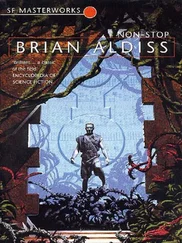BRIAN ALDISS
Those who seek for revelation become themselves a revelation

Copyright Contents Cover Title Page Copyright PART ONE: G Who Waits Chapter One Chapter Two Chapter Three Chapter Four Chapter Five Chapter Six PART TWO: S The Watchful Chapter One Chapter Two Chapter Three Chapter Four Chapter Five Chapter Six PART THREE: The House and The Watchers Chapter One Chapter Two Chapter Three Chapter Four About the Author Also by Brian Aldiss About the Publisher
Harper Voyager an imprint of
HarperCollins Publishers Ltd
1 London Bridge Street
London SE1 9GF
www.harpervoyagerbooks.co.uk
This ebook edition first published in Great Britain by Harper Voyager 2015
First published in Great Britain by Faber and Faber 1968
Copyright © Brian Aldiss 2015
Cover design © HarperCollins Publishers Ltd 2015
Brian Aldiss asserts the moral right to be identified as the author of this work.
A catalogue copy of this book is available from the British Library.
This novel is entirely a work of fiction. The names, characters and incidents portrayed in it are the work of the author’s imagination. Any resemblance to actual persons, living or dead, events or localities is entirely coincidental.
All rights reserved under International and Pan-American Copyright Conventions. By payment of the required fees, you have been granted the non-exclusive, non-transferable right to access and read the text of this e-book on screen. No part of this text may be reproduced, transmitted, down-loaded, decompiled, reverse engineered, or stored in or introduced into any information storage and retrieval system, in any form or by any means, whether electronic or mechanical, now known or hereinafter invented, without the express written permission of HarperCollins.
Source ISBN: 9780007482405
Ebook Edition © October 2015 ISBN: 9780007482412
Version: 2015-08-28
Contents
Cover
Title Page BRIAN ALDISS
Copyright
PART ONE: G Who Waits
Chapter One
Chapter Two
Chapter Three
Chapter Four
Chapter Five
Chapter Six
PART TWO: S The Watchful
Chapter One
Chapter Two
Chapter Three
Chapter Four
Chapter Five
Chapter Six
PART THREE: The House and The Watchers
Chapter One
Chapter Two
Chapter Three
Chapter Four
About the Author
Also by Brian Aldiss
About the Publisher
PART ONE
The Report begins:
One afternoon early in a certain January, the weather showed a lack of character. There was no frost or wind; the trees in the garden did not stir. There was no rain, although anybody accustomed to predicting rain might have forecast it with a fair expectation of being right before nightfall. Cloud lay thickly over the sky. The face of the sun was not visible. Consequently, shadows had no form.
A single window on the north-west side of the house reflected the light back in a dull fashion, without movement, except once when the reflection of a pigeon, wheeling above the garden, splashed across it. No movement came from the house. No sound came from the house.
G lived not in the house but in a wooden bungalow in the garden, overlooked by the window set high in the north-west side of the house. The bungalow, which contained only one room, measured about five by four metres, being longer than it was deep. It was raised above the ground on low pillars of brick. It was constructed of planks arranged vertically on the front and rear and horizontally on the sides. Its roof was also of planks, covered by asphalt; the asphalt was secured in place by large flat-headed nails which dug into the black material. Cracks ran round many of the nails.
The wooden bungalow had two windows. These were fitted in its front wall, one on either side of a door. This was the only door. It did not fit well. The windows contained large single panes of glass. The window-frames and the door had been painted with white paint. Although dirt had greyed this paint, it was still in moderately good condition and not in particular need for repainting. The rest of the wooden bungalow, excluding of course the roof, had been painted yellow. This paint had proved less satisfactory than the white, peeling off in many places to reveal the bare wood underneath.
Between the two windows was an ill-fitting door. A key remained in the lock of this door on the inside, although the lock would not function because the door hinges had sunk and the wood had swollen. G always shut this door with great force at night; he did not like to imagine that Mr Mary might enter the wooden bungalow when he was inside it asleep. Sometimes when G shut the door with great force at night, the key would fall out of the lock onto the mat.
Approximately two years had passed since G began living in the wooden bungalow. During that period, the key had fallen onto the mat inside the door on many occasions.
When Mr Mary had had men build the wooden bungalow in the garden, he said to his wife: ‘It is for you; you can call it your summer house.’ The wooden bungalow had been constructed facing the north-west side of the house. It did not face it squarely, but at an angle of some twenty degrees, in the direction of east-south-east. It stood at a distance of some ten metres from the house. The house dominated the wooden bungalow.
On the early January days when the sun shone, it never rose far enough above the roof of the house to illuminate more than the upper half of the two windows on the front of the bungalow. Even this ration of sunshine was further abbreviated while the shadow of a group of chimneys on the roof of the house made its passage across the front of the bungalow. Since the bungalow faced east-south-east, the sunshine that did reach the windows impinged obliquely into the one room. It shone onto a small section of mat that was stretched over the floorboards and over a portion of the couch on which G slept. G was never on the couch when the sun was.
The couch stood along the northmost side of the room. At the other end of the room to the couch, G had a small stove of an antique pattern which burnt paraffin. By this stove was a chair on which G sat for a considerable period each day. One of the rear legs of this chair was slightly shorter than the others, so that it was possible to make the chair rock a little when one wished it to do so. The chair had once belonged in the house. The style of the chair was the style known to G as wheelback, because the spokes that formed the back of the chair radiated out from a centre in a fashion reminiscent of the hubs of a cart wheel. The back of the chair had once possessed five supports or spokes; one of these spokes had been missing for a long time. It was because this spoke was missing that Mr Mary had ordered the chair to be placed in the wooden bungalow. The chair had been made shortly before the first world war; it bore on the underside of the round wooden seat the date 1912. G had seen this date and did not forget it.
When G sat on the chair, he generally permitted his gaze to rest only on the objects inside the bungalow. These objects were few in number. He was familiar with all of them. Most of the objects were manufactured, as were a stove with a pattern of circular holes on its upper surface and a galvanised bucket that stood near the chair. Most of them had not been intended originally for the wooden bungalow, but had been brought over by his wife, before they had quarrelled. One or two belonged to G.
Читать дальше











